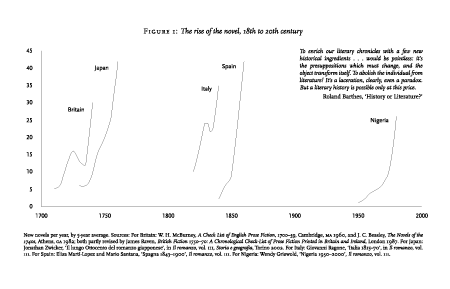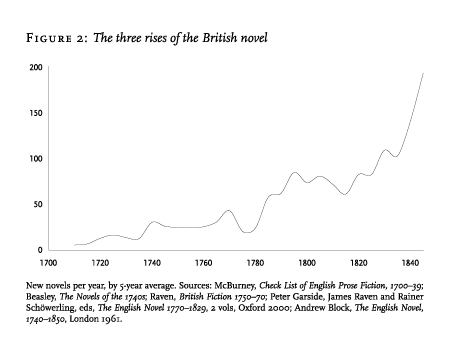What follows is the first of three interconnected articles, whose common purpose is to delineate a transformation in the study of literature. Literature, the old territory; but within it, a shift from the close reading of individual texts to the construction of abstract models. The models are drawn from three disciplines—quantitative history, geography and evolutionary theory: graphs, maps and trees—with which literary criticism has had little or no interaction; but which have many things to teach us, and may change the way we work.footnote1
The old historical paradigm, writes Krzysztof Pomian, ‘directed the gaze of the historian towards extraordinary events . . . historians resembled collectors: both gathered only rare and curious objects, disregarding whatever looked banal, everyday, normal’.footnote2 What changed the situation, Pomian goes on, was the shift ‘from exceptional events to the large mass of facts’ introduced by the Annales school, and the present article tries to imagine what would happen if we, too, shifted our focus from exceptional texts to ‘the large mass of [literary] facts’. It’s an idea that occurred to me some years ago, when the study of national bibliographies made me realize what a minimal fraction of the literary field we all work on: a canon of two hundred novels, for instance, sounds very large for nineteenth-century Britain (and is much larger than the current one), but is still less than one per cent of the novels that were actually published: twenty thousand, thirty, more, no one really knows—and close reading won’t help here, a novel a day every day of the year would take a century or so . . . And then, a field this large cannot be understood by stitching together separate bits of knowledge about individual cases, because it isn’t a sum of individual cases: it’s a collective system, that should be grasped as such, as a whole—and the graphs that follow are one way to begin doing this. Or as Fernand Braudel put it in the lecture on history he gave to his companions in the German prison camp near Lübeck:
An incredible number of dice, always rolling, dominate and determine each individual existence: uncertainty, then, in the realm of individual history; but in that of collective history . . . simplicity and consistency. History is indeed ‘a poor little conjectural science’ when it selects individuals as its objects . . . but much more rational in its procedures and results, when it examines groups and repetitions.footnote3
A more rational literary history. That is the idea.
The quantitative approach to literature can take several different forms—from computational stylistics to thematic databases, book history, and more. For reasons of space, I will here limit myself to book history, building on work originally done by McBurney, Beasley, Raven, Garside and Block for Britain; Angus, Mylne and Frautschi for France; Zwicker for Japan; Petersen for Denmark; Ragone for Italy; Martí-Lopez and Santana for Spain; Joshi for India; and Griswold for Nigeria. And I mention these names right away because quantitative work is truly cooperation: not only in the pragmatic sense that it takes forever to gather the data, but because such data are ideally independent from any individual researcher, and can thus be shared by others, and combined in more than one way. Figure 1, which charts the take-off of the novel in Britain, Japan, Italy, Spain and Nigeria, is a case in point. See how similar those shapes are: five countries, three continents, over two centuries apart, and it’s really the same pattern, the same old metaphor of the ‘rise’ of the novel come alive: in twenty years or so (in Britain, 1720–40; Japan, 1745–65; Italy, 1820–40; Spain, 1845 to early 1860s; Nigeria, 1965–80), the graph leaps from five–ten new titles per year, which means one new novel every month or two, to one new novel per week. And at this point, the horizon of novel-reading changes. As long as only a handful of texts are published each year, that is, the novel is an unreliable commodity: it disappears for long stretches of time, and cannot really command the loyalty of the reading public; it resembles a fashion, more than a literary genre. With a new text every week, however, the novel becomes that great modern oxymoron of the regular novelty: the unexpected that consumers expect so often and eagerly that they can no longer do without it. The novel ‘becomes a necessity of life’, to paraphrase a book by William Gilmore-Lehne, and the jeremiads that immediately multiply around it—novels make readers lazy, dissolute, insane, insubordinate: just like films two centuries later—are the sign of its symbolic triumph.
The rise of the novel, then; or, better, one rise in a history which had begun many centuries earlier, and will go through several other accelerations, as emerges quite clearly from the data on the publication of new novels in Britain between 1710 and 1850 (figure 2). Here, three phases seem to stand out, each subdivided into a first period of rapid growth and a second one of stabilization, and each modifying in a specific way the social role of the novel. The first phase, from 1720 to around 1770, is the one discussed above: a leap in 1720–40, and a consolidation in the following decades. In the second phase, which runs from 1770 to around 1820, the further increase in the number of new titles induces for its part a drastic reorientation of audiences towards the present. Up to then, I mean, the ‘extensive’ reading so typical of the novel—reading many texts once and superficially, rather than a few texts often and intensely—would easily outgrow the yearly output of titles, forcing readers to turn to the past for (much of) their entertainment: all sorts of reprints and abridgements of eighteenth-century bestsellers, British as well as foreign, plus the old, and even the few ancient classics of the genre. But as the total of new novels doubles, compared to the previous phase—80 in 1788; 91 in 1796; 111 in 1808—the popularity of old books suddenly collapses, and novelistic audiences turn resolutely (and irreversibly) towards the current season.footnote4
The third phase, which begins around 1820, and which unfortunately I can only follow for the first thirty years, is the one in which the internal composition of the market changes. So far, the typical reader of novels had been a ‘generalist’—someone ‘who reads absolutely anything, at random’, as Thibaudet was to write with a touch of contempt in Le liseur de romans.footnote5 Now, however, the growth of the market creates all sorts of niches for ‘specialist’ readers and genres (nautical tales, sporting novels, school stories, mystères): the books aimed at urban workers in the second quarter of the nineteenth century, or at boys, and then girls, in the following generation, are simply the most visible instances of this larger process, which culminates at the turn of the century in the super-niches of detective fiction and then science fiction.

